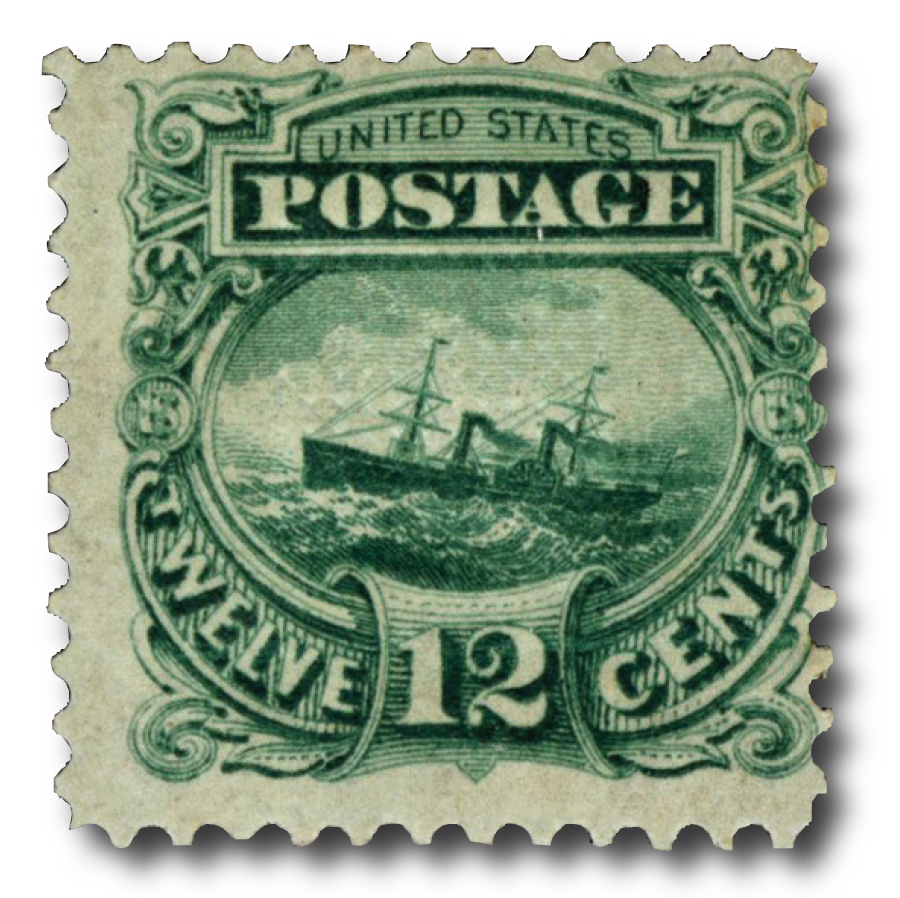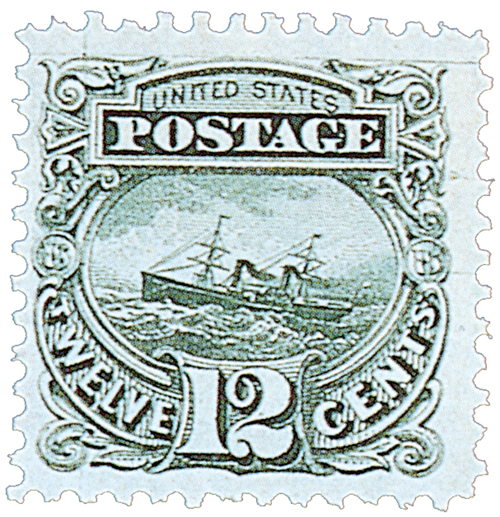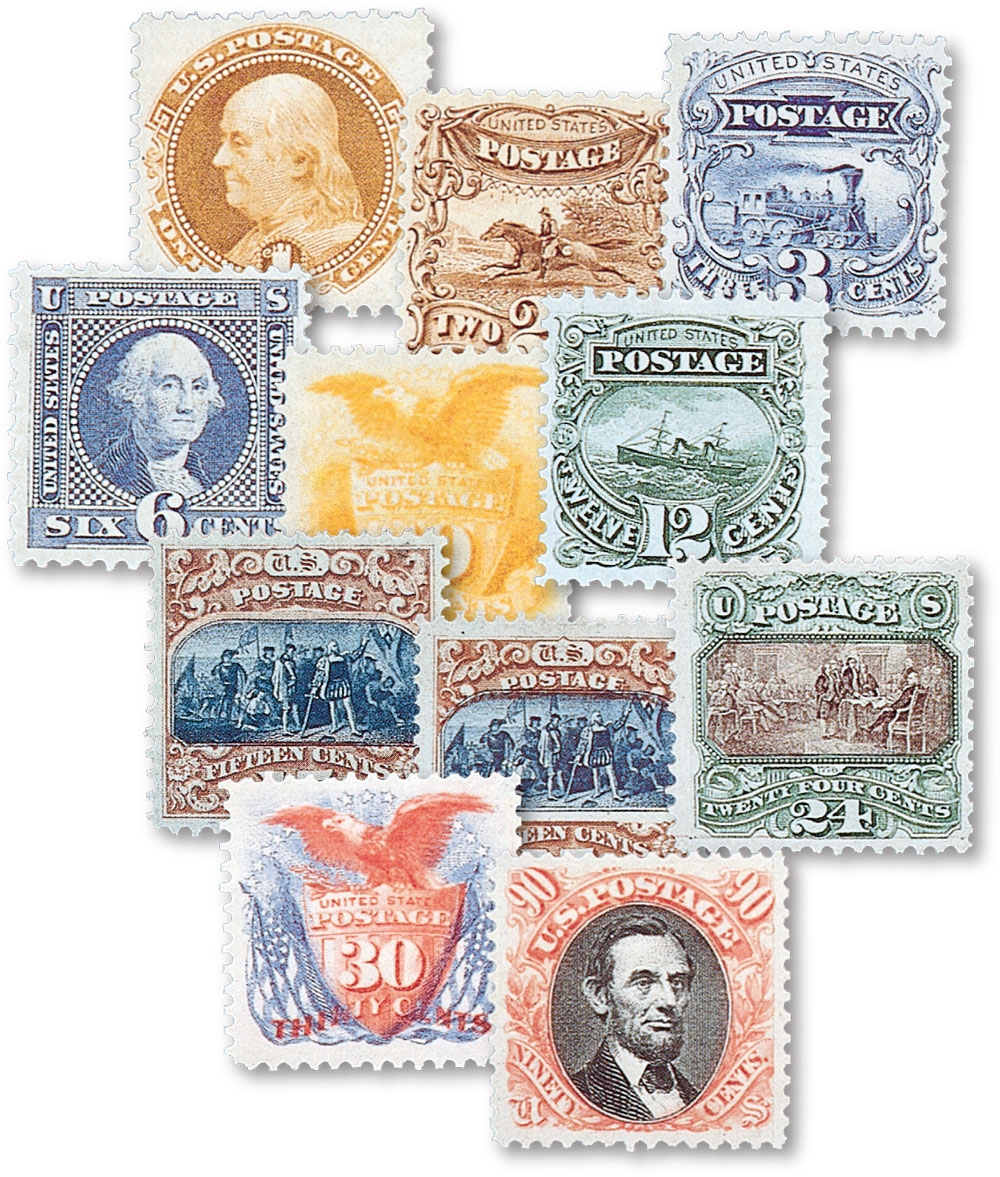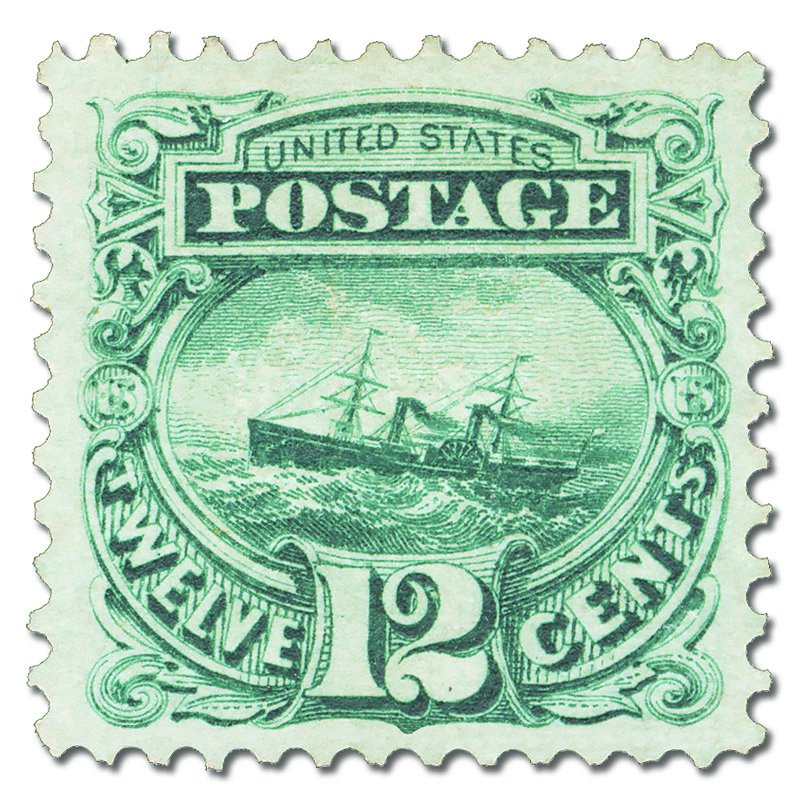
# 117 offer - 1869 12c S.S. Adriatic, green
1869 12¢ S.S. Adriatic Pictorial
G Grill
Earliest Known Use: April 1, 1869
Quantity issued: 3,012,700
Printed by: National Bank Note Company
Method: Flat plate
Watermark: None
Perforation: 12
Color: Green
SS Adriatic
The Adriatic was built by the New York & Liverpool United States Mail Steamship Company, which was founded in 1818. Also known as the Collins Line, it was founded by Israel Collins and later expanded by his son Edward Knight Collins.
By 1835, Edward established the Collins Line as one of the major American shipping firms, carrying large amounts of cotton to England. They produced the largest ships they could, often outsizing their competitors.

In 1849, Collins won a ten-year contract to deliver mail between New York and Liverpool. They had new ships built for the service that were twice the size of the British ships of the Cunard Line and could travel up to 12 knots faster. They also had many innovations including steam heat, running water, ventilation in all the rooms, bathing cabins, and a salon.
In 1854, one of Collins’ ships collided with another vessel in thick fog and sank. Some 322 passengers died, including Collins’ wife and children. Despite his grief, Collins was determined to push forward and resolved to build a bigger, faster, and more luxurious ship, the Adriatic. Launched on April 7, 1856, the Adriatic was 355 feet long, weighed 3,670 tons, and could reach a speed of 13 knots.

The Adriatic was supposed to go into service that November, but was delayed due to technical problems. The following year the ship completed its sea trials and was ready for service.
The Adriatic was a shining example of modern innovation. It was the largest and fastest ocean liner in the world and considered a modern marvel at the time. However, its late delivery caused financial troubles for the company and they soon went bankrupt.

The Adriatic made one voyage under the Collins Line before the company went bankrupt. It was then sold to the Royal Atlantic Steam Navigation Company. In 1861, the ship set a transatlantic record, traveling from Galway, Ireland, to St. John’s, Newfoundland, in just five days and 19 hours. Today that’s quaint, but at the time it was astounding. In 1868, it was sold again, to Bates & Co. of Liverpool. Under that service the Adriatic was converted to a sailing ship. It had its last voyage in 1885, when it went aground on Africa’s West Coast.
The Pictorial Series
The appearance of the 1869 Pictorials marked a significant change in US stamp design. For the first time in American postal history, something other than portraits of national leaders was being pictured on a stamp. These were the first US stamps to be printed using two colors.

The pictorials were to be produced over a four-year period by the National Bank Note Company. When issued, however, the stamps were unpopular with the general public. Within a year after their release, they were withdrawn from sale.
Today, the pictorial issues are the most popular of the 1840 – 1870 classic stamps. Because the stamps were only in circulation for a year, they have become increasingly hard to find.
The SS Adriatic stamp is considered to have the best design of the entire Pictorial Series. It typically paid the double-weight rate for letters bound for Great Britain. So the Adriatic design was a perfect celebration of mail transportation by ocean-going steamer.
Click here to view the rest of Pictorials.
1869 12¢ S.S. Adriatic Pictorial
G Grill
Earliest Known Use: April 1, 1869
Quantity issued: 3,012,700
Printed by: National Bank Note Company
Method: Flat plate
Watermark: None
Perforation: 12
Color: Green
SS Adriatic
The Adriatic was built by the New York & Liverpool United States Mail Steamship Company, which was founded in 1818. Also known as the Collins Line, it was founded by Israel Collins and later expanded by his son Edward Knight Collins.
By 1835, Edward established the Collins Line as one of the major American shipping firms, carrying large amounts of cotton to England. They produced the largest ships they could, often outsizing their competitors.

In 1849, Collins won a ten-year contract to deliver mail between New York and Liverpool. They had new ships built for the service that were twice the size of the British ships of the Cunard Line and could travel up to 12 knots faster. They also had many innovations including steam heat, running water, ventilation in all the rooms, bathing cabins, and a salon.
In 1854, one of Collins’ ships collided with another vessel in thick fog and sank. Some 322 passengers died, including Collins’ wife and children. Despite his grief, Collins was determined to push forward and resolved to build a bigger, faster, and more luxurious ship, the Adriatic. Launched on April 7, 1856, the Adriatic was 355 feet long, weighed 3,670 tons, and could reach a speed of 13 knots.

The Adriatic was supposed to go into service that November, but was delayed due to technical problems. The following year the ship completed its sea trials and was ready for service.
The Adriatic was a shining example of modern innovation. It was the largest and fastest ocean liner in the world and considered a modern marvel at the time. However, its late delivery caused financial troubles for the company and they soon went bankrupt.

The Adriatic made one voyage under the Collins Line before the company went bankrupt. It was then sold to the Royal Atlantic Steam Navigation Company. In 1861, the ship set a transatlantic record, traveling from Galway, Ireland, to St. John’s, Newfoundland, in just five days and 19 hours. Today that’s quaint, but at the time it was astounding. In 1868, it was sold again, to Bates & Co. of Liverpool. Under that service the Adriatic was converted to a sailing ship. It had its last voyage in 1885, when it went aground on Africa’s West Coast.
The Pictorial Series
The appearance of the 1869 Pictorials marked a significant change in US stamp design. For the first time in American postal history, something other than portraits of national leaders was being pictured on a stamp. These were the first US stamps to be printed using two colors.

The pictorials were to be produced over a four-year period by the National Bank Note Company. When issued, however, the stamps were unpopular with the general public. Within a year after their release, they were withdrawn from sale.
Today, the pictorial issues are the most popular of the 1840 – 1870 classic stamps. Because the stamps were only in circulation for a year, they have become increasingly hard to find.
The SS Adriatic stamp is considered to have the best design of the entire Pictorial Series. It typically paid the double-weight rate for letters bound for Great Britain. So the Adriatic design was a perfect celebration of mail transportation by ocean-going steamer.
Click here to view the rest of Pictorials.















